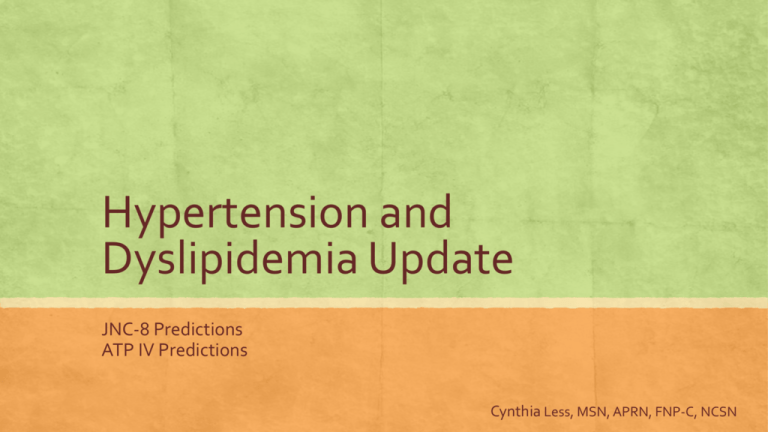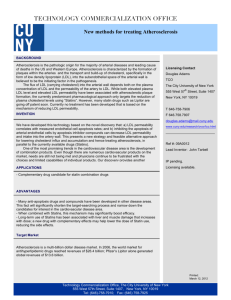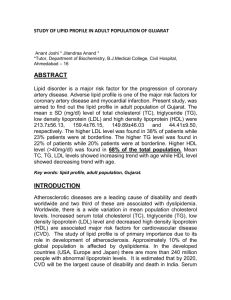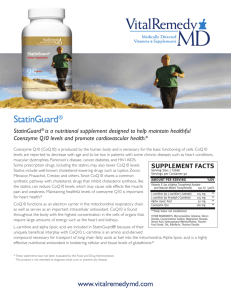File
advertisement

Hypertension and Dyslipidemia Update JNC-8 Predictions ATP IV Predictions Cynthia Less, MSN, APRN, FNP-C, NCSN Hypertension ▪ 74.5 Million Hypertensive Americans ▪ HTN - Risk Factor for the following: ▪ Premature Cardiovascular Disease ▪ Heart Failure ▪ Stroke ▪ Chronic Kidney Disease and ESRD ▪ Cognitive Decline ▪ Premature Death http://www.cdc.gov/nchs/data/databriefs/db107.htm World Hypertension League http://www.worldhypertensionleague.org/Pages/Home.aspx World Health Organization http://www.who.int/gho/ncd/risk_factors/blood_pressure_prevalence/en/index.html Blood Pressure Formula • Blood Pressure = Stroke Volume x Heart Rate x Peripheral Vascular Resistance • A rise in any of the components will cause higher BP • A drop in any of the components will cause lower BP • Highest PVR found in elders, DM, African ancestry Target Organ Damage ▪ Heart ▪ Left Ventricular Hypertrophy ▪ Angina / prior MI ▪ Prior coronary revascularization ▪ Heart failure ▪ Brain ▪ Stroke or transient ischemic attack ▪ Dementia ▪ Chronic Kidney Disease ▪ Peripheral Arterial Disease ▪ Retinopathy CVD Risk Factors ▪ ▪ ▪ ▪ ▪ ▪ ▪ ▪ ▪ Age (Male 55, Female 65) Hypertension Diabetes mellitus Elevated LDL or low HDL Family history of premature CVD Microalbuminuria or estimated GFR < 60 mL / min Obesity Physical inactivity Tobacco use Diagnosing Hypertension ▪ Clinic BP Measurement ▪ Home BP Monitors ▪ Ambulatory BP Monitors Accurate Blood Pressure Measurement ▪ Must sit for 5 minutes ▪ ▪ ▪ ▪ ▪ ▪ Back supported against chair, feet flat on floor Cuff must encircle 80 % of arm circumference Arm supported at level of the heart Average of 2 readings at least 2 minutes apart Repeat set if more than 5 mmHg apart No caffeine, smoking, or exercise 30 minutes prior The Seventh Report of the Joint National Committee on Prevention, Evaluation, and Treatment of High Blood Pressure. National Heart, Lung, and Blood Institute. December 2003. Joint National Committee on Prevention Detection, Evaluation and Treatment of High Blood Pressure JNC-7 • 50 years and older = systolic pressure greater than 140 is much more important risk factor for CVD than diastolic • The risk of CVD beginning at 115/75 doubles with each increment of 20/10 • Systolic of 120-139 or diastolic of 80-89 should be considered pre-hypertensive • Persons normotensive at age 55 have a 90% lifetime HTN risk JNC-7 Classifications B/P CLASS SBP DBP <120 And <80 Prehypertension 120-139 Or 80-89 Stage 1 140-159 Or 90-99 Stage 2 >160 Or >100 Normal 2007 European Societies of HTN and Cardiology: Classification of HTN BP Classification SBP mmHg DBP mmHg Optimal BP < 120 < 80 Normal 120 - 129 and /or 80 - 84 High Normal 130 - 139 and /or 85 - 89 Grade 1 140 - 159 and / or 90 - 99 Grade 2 160 - 179 and / or 100 - 109 Grade 3 > 180 and / or > 110 Isolated Systolic HTN 140 < 90 Mancia, G. et al. 2007 Guidelines for the Management of Arterial HTN: The Task Force for the Management of Arterial HTN of the Euro Soc of HTN (ESH) and of the Euro Soc of Card (ESC). J HTN 2007; 25: 1105. Results of BP Screenings ▪ ▪ ▪ ▪ ▪ Recheck in 2 years if normal Recheck in 1 year if prehypertension Stage 1 - Confirm in 2 months Stage 2 - Confirm in 1 month If > 180 / 110, treat now Classification of Prehypertension and Hypertension in Children and Adolescents Classification Normal Prehypertension Stage 1 hypertension Stage 2 hypertension Systolic or diastolic blood pressure* < 90th percentile 90th to < 95th percentile or ≥ 120/80 mm Hg† 95th to < 99th percentile plus 5 mm Hg > 99th percentile plus 5 mm Hg *—Based on sex, age, and height; measured on at least three separate occasions. †—Blood pressure of 120/80 mm Hg or greater is prehypertension regardless of whether it is less than the 90th percentile. If 120/80 mm Hg is in the 95th percentile or greater, then the patient has hypertension. Am Family Physician. 2012 Apr 1;85(7):693-700 Children and Adolescents • HTN defined as BP—95th percentile or greater, adjusted for age, height, and gender • Use lifestyle interventions first, then drug therapy for higher levels of BP or if insufficient response to lifestyle modifications Children and Adolescents • Drug choices similar in children and adults, but effective doses are often smaller • Uncomplicated primary HTN is not a reason to restrict physical activity Benefits of Lowering BP • Stroke incidence =35–40% reduction • Myocardial infarction=20–25% reduction • Heart failure=50% reduction Lifestyle Modification Approximate SBP Reduction-Range with Modification • • • • • Weight reduction DASH eating plan Sodium reduction Physical activity Moderate alcohol consumption 5–20 mmHg/10 kg weight loss 8–14 mmHg 2–8 mmHg 4–9 mmHg 2–4 mmHg Medications • Lifestyle changes FIRST • Medications have SIDE EFFECTS • Prescription is based on underlying diagnosis • Comorbidities Medications A B C D ACEIs/ARBs Beta-Blockers CCBs Diuretics DM, CHF, Post MI Young CHF, Post MI Young Black Elderly Black Elderly Angioedema Cough 30% rate Increased K+ Low Na+ Can increase lipids, cholesterol Increased depression Increased asthma, COPD symptoms Dihydroperidines: edema, constipation, heart failure Non-Dihydroperidines: decreased heart rate HCTZ: low K+, increased Ca++, increased uric acid, increased lipids, increased glucose, low Na+, increased Cr Loop: low K+, low Ca++, low Na+, increased Cr The Renin Angiotensin System Gum hyperplasia Fatigue Non-adherence ▪ ▪ ▪ ▪ ▪ ▪ Misunderstanding of condition Denial of illness / Asymptomatic Lack of patient involvement in care plan Unexpected adverse effects of medicine Too many follow-up visits, lab requests Emphasis on PCMH Goals / Objectives The Seventh Report of the Joint National Committee on Prevention, Evaluation, and Treatment of High Blood Pressure. National Heart, Lung, and Blood Institute. Dec 2003. HTN Emergency DBP=>120 mg Hg “The presence of acute or ongoing end organ damage constitutes a hypertensive emergency, whereas the absence of such complications is known as a hypertensive urgency.” • Acute heart failure • Acute coronary syndrome • Stroke or encephalopathy • Intracranial hemorrhage • Acute target organ damage (TOD) Bales, A, Hypertensive crisis: How to tell if it's an emergency or an urgency, Postgraduate Medicine, vol 105, no 5, 99, available at www.postgraduatemedicine.com HTN Urgency • Stage 2 HTN without treatment • No evidence of acute onset TOD • Alert • No headache or chest pain • Treatment Goal • Prompt but gradual BP reduction • 25% reduction of mean arterial pressure or • Diastolic pressure to 100 to 110 mm Hg over next several minutes to several hours Questions? ▪ What now? ▪ Do we continue current practices “as is”? ▪ Monitor how BPs are screened ▪ Question and change confirmation methods ▪ Adapt ambulatory BP monitor / HBPM ▪ Change preferences for 1st line agents ▪ Change preferences for 1st line combination medications • • • U.S. guidelines for the detection, evaluation, and treatment of hyperlipidemia in adults Developed by an expert panel for the National Heart, Lung, and Blood Institute (NHLBI) • Division of National Institutes of Health (NIH) • Long history of developing clinical practice guidelines • First JNC report published 1977 ATP release history: • ATP I First released in 1988 • ATP II 1993 • ATP III 2001 National Cholesterol Education Program (NCEP) Adult Treatment Panel (ATP) Guidelines Lipid Review Cholesterol (Understanding Disease: Cardiovascular Medicine) http://www.youtube.com/watch?NR=1&v=mCYAOeEe6w&feature=endscreen Biology of Progression of Atherosclerosis http://www.youtube.com/watch?feature=player_detailpag e&v=Yyr67JBiU0Q Adult Treatment Panel III (ATP III) • Provides clinical guidelines for treatment for cholesterol testing and management • Evidence-based and extensively referenced • Provides scientific rationale for the recommendations • ATP I and II focused on patients with CHD • ATP III thrust in on primary prevention in persons with multiple risk factors ATP III Guidelines Risk Category High Risk CHD or Risk Equivalents (10 YR >20%) Moderate Risk 2+ risk factors (10 YR 10-20%) Moderate Risk 2+ risk factors (10 year risk <10%) Low Risk 0-1 risk factor LDL Goal <100 Drug Treatment >100 (optional for very high <100 consider drug risk <70) treatment <130 >130 <130 >160 <160 >190 Updates to ATP III (July 2004) ▪ Update on ATP III Guidelines based on the review of 5 clinical trials of cholesterollowering statin treatment that were conducted after the release of ATP III UPDATE 1 ▪ ATP III emphasizes therapeutic lifestyle changes: ▪ Low saturated fat and low cholesterol diet ▪ Increased physical activity ▪ Weight control ▪ These remain the cornerstone of treatment for lowering cholesterol levels UPDATE 2 ▪ Modifications for high risk patients ▪ CHD, PVD, CVA, Diabetes or 2 or more risk factors that give them 20% 10 year risk ▪ LDL <100 ▪ Modifications for very high risk patients ▪ Had a recent heart attack or CHD combined with diabetes or severe or poorly controlled risk factors or metabolic syndrome ▪ LDL < 70 UPDATE 3 ▪ High Risk patients recommend consider drug treatment for LDL >100 ▪ Optional drug treatment for LDL <100 ▪ ATP III advises that the intensity of the LDL lowering drug treatment in high risk and moderate risk patient be sufficient to achieve at least 30% reduction in LDL levels UPDATE 4 ▪ Moderately high risk patients - > 2 risk factors together with a 10-20% 10 y risk ▪ Recommend drug treatment for LDL >130 ▪ Overall goal for moderately high risk patient is still LDL < 130 there is therapeutic option to set the treatment goal at an LDL <100 and to use drug treatment if LDL is 100-129 Cut Points for Total Cholesterol and LDL Concentrations in Children and Adolescents Category Percentile Total cholesterol (mg per dL) LDL (mg per dL) Acceptable < 75th < 170 < 110 Borderline 75th to 95th 170 to 199 110 to 129 Elevated > 95th > 200 > 130 Am Family Physician. 2009 Apr 15;79(8):703-705. AAP Clinical Report on Lipid Screening in Children Pediatric Lipid Screening Recommendations Lipids 0 to 12 months 1 to 4 years No routine lipid Obtain fasting screening lipid profile only if family history for CVD is positive, parent has dyslipidemia, child has any other risk factors or highrisk condition 5 to 9 years Obtain fasting lipid profile only if family history for CVD is positive, parent has dyslipidemia, child has any other risk factors or highrisk condition 9 to 11 years Obtain universal lipid screen with non-fasting non-HDL cholesterol (total cholesterol minus HDL cholesterol), or fasting lipid profile; manage per lipid algorithms as needed 12 to 17 years Obtain fasting lipid profile if family history newly positive, parent has dyslipidemia, child has any other risk factors or highrisk condition; manage per lipid algorithms as needed 18 to 21 years Measure one non-fasting non-HDL cholesterol or fasting lipid profile in all: review with patient; manage with lipid algorithms per Adult Treatment Panel guidelines as needed Published source: Pediatrics, December 2011 NHLBI Guidelines U.S. Preventative Services Task Force (USPTF) A—Strongly Recommended: The USPSTF strongly recommends that clinicians provide [the service] to eligible patients. The USPSTF found good evidence that [the service] improves important health outcomes and concludes that benefits substantially outweigh harms. B—Recommended: The USPSTF recommends that clinicians provide [the service] to eligible patients. The USPSTF found at least fair evidence that [the service] improves important health outcomes and concludes that benefits outweigh harms. C—No Recommendation: The USPSTF makes no recommendation for or against routine provision of [the service]. The USPSTF found at least fair evidence that [the service] can improve health outcomes but concludes that the balance of benefits and harms is too close to justify a general recommendation. D—Not Recommended: The USPSTF recommends against routinely providing [the service] to asymptomatic patients. The USPSTF found at least fair evidence that [the service] is ineffective or that harms outweigh benefits. I—Insufficient Evidence to Make a Recommendation: The USPSTF concludes that the evidence is insufficient to recommend for or against routinely providing [the service]. Evidence that the [service] is effective is lacking, of poor quality, or conflicting and the balance of benefits and harms cannot be determined U.S. Preventive Services Task Force. Screening for Lipid Disorders in Adults: U.S. Preventive Services Task Force Recommendation Statement. June 2008. http://www.uspreventiveservicestaskforce.org/uspstf08/lipid/lipidrs.htm Summary of Recommendations Screening Men • The USPSTF strongly recommends screening men aged 35 and older for lipid disorders. Grade: A recommendation • The USPSTF recommends screening men aged 20 to 35 for lipid disorders if they are at increased risk for coronary heart disease. Grade: B recommendation U.S. Preventive Services Task Force. Screening for Lipid Disorders in Adults: U.S. Preventive Services Task Force Recommendation Statement. June 2008. http://www.uspreventiveservicestaskforce.org/uspstf08/lipid/lipidrs.htm Summary of Recommendations Screening Women at Increased Risk • The USPSTF strongly recommends screening women aged 45 and older for lipid disorders if they are at increased risk for coronary heart disease. Grade: A recommendation • The USPSTF recommends screening women aged 20 to 45 for lipid disorders if they are at increased risk for coronary heart disease. Grade: B recommendation U.S. Preventive Services Task Force. Screening for Lipid Disorders in Adults: U.S. Preventive Services Task Force Recommendation Statement. June 2008. http://www.uspreventiveservicestaskforce.org/uspstf08/lipid/lipidrs.htm Summary of Recommendations Screening Young Men and All Women Not at Increased Risk • The USPSTF makes no recommendation for or against routine screening for lipid disorders in men aged 20 to 35, or in women aged 20 and older who are not at increased risk for coronary heart disease. U.S. Preventive Services Task Force. Screening for Lipid Disorders in Adults: U.S. Preventive Services Task Force Recommendation Statement. June 2008. http://www.uspreventiveservicestaskforce.org/uspstf08/lipid/lipidrs.htm Framingham Risk Assessment Tool • Background • Derived from the Framingham Heart Study • Validated method to predict 10-year risk of ‘hard’ coronary heart disease (nonfatal MI or coronary death) • Used in those without risk equivalents (e.g. CKD, DM) • Score • Low <10%, Moderate 10-20%, High >20% • Limitations • Predicts risk best • ages 30-65 • Less precise in those with diabetes, pre-diabetes, severe HTN, LVH, younger men and women, and some racial groups – Japanese-Americans, Hispanic men, and Native American women. • Limited to estimation of 10-year risk • Available at http://hp2010.nhlbihin.net/atpiii/calculator.asp For primary prevention, at what age is lipid screening no longer beneficial? ▪ Age is the single most important predictor of CVD risk, so the chance of an event only increases with age. PROSPER looked at patients 70-82 years of age and found that adding a statin reduced mortality by 24% in this group. How do you manage elevated cholesterol in children and adolescents? ▪ Pediatric guidelines TG >200 or LDL >130 diet therapy needs to be instituted by nutritionist ▪ Pediatric patients with LDL> 190 should be referred for heterozygous familial hypercholesterolemia. Statin therapy is indicated in most of these patients What are the risks of lowering LDL too low? ▪ PROVE-IT looked at LDL as low as 40 in very high risk patients in the setting of acute coronary syndrome. Remember that children have LDL levels in this low range which provides enough cholesterol for normal development ▪ Based on current trials there does not seem to a level that is too low Statins ▪ Inhibit HMG-CoA reductase ▪ Enzyme responsible for conversion of HMG-CoA to mevalonate, and decreases hepatic biosynthesis of cholesterol ▪ As a result, hepatocytes compensate by increasing the number of LDL surface receptors to increase LDL reuptake from the circulation ▪ End result is reduction of serum LDL concentration Effects of Drugs on LDL, HDL, and TG DRUG Lower LDL Higher HDL Lower TG Nicotinic Acid 5-25% 15-35% 20-50% Fibrates 5-20% 10-20% 25-50% Fish Oils 2-5% No Change 30-40% Statins 18-55% 5-15% 7-30% Bile Acid Resins 15-30% 3-5% 0-15% Niacin (Nicotinic Acid) ▪ Mechanism of action ▪ Increases activity of lipase, which breaks down lipids ▪ Reduces the metabolism of cholesterol and triglycerides ▪ ↑HDL 15–35% ▪ ↓TG 20–50% ▪ ↓LDL 5–25% ▪ Effective against highly atherogenic LDL lipoprotein (a) ▪ Caution: flushing (due to histamine release), hepatotoxicity, hyperuricemia, hyperglycemia, pruritus Effects of Drugs on LDL, HDL, and TG DRUG Lower LDL Higher HDL Lower TG Nicotinic Acid 5-25% 15-35% 20-50% Fibrates 5-20% 10-20% 25-50% Fish Oils 2-5% No Change 30-40% Statins 18-55% 5-15% 7-30% Bile Acid Resins 15-30% 3-5% 0-15% Fibric Acid Derivatives (Fibrates) ▪ Mechanism of action ▪ Activates lipase, which breaks down cholesterol ▪ Suppresses release of free fatty acid from the adipose tissue, inhibits synthesis of triglycerides in the liver, and increases the secretion of cholesterol in the bile ▪ ↑HDL 10–20% ▪ ↓ TG 20–50% ▪ ↓ LDL 5–20% (with normal TG) ▪ May raise LDL-C (with high TG) ▪ Adverse Effects ▪ Dyspepsia, increased risk of gallstones ▪ When combined with statin, can produce rhabdomyolysis Effects of Drugs on LDL, HDL, and TG DRUG Lower LDL Higher HDL Lower TG Nicotinic Acid 5-25% 15-35% 20-50% Fibrates 5-20% 10-20% 25-50% Fish Oils 2-5% No Change 30-40% Statins 18-55% 5-15% 7-30% Bile Acid Resins 15-30% 3-5% 0-15% Bile Acid Resins ▪ Also called bile acid sequestrants because they sequester bile acid in the gut so there is a decrease in cholesterol production ▪ Nonsystemic ▪ ▪ ▪ ▪ ↓LDL 15–30% ↑ HDL 3–5% ↑ TG if =>400 mg/dL Adverse Effects ▪ GI upset, constipation, drug interactions Effects of Drugs on LDL, HDL, and TG DRUG Lower LDL Higher HDL Lower TG Nicotinic Acid 5-25% 15-35% 20-50% Fibrates 5-20% 10-20% 25-50% Fish Oils 2-5% No Change 30-40% Statins 18-55% 5-15% 7-30% Bile Acid Resins 15-30% 3-5% 0-15% Essential fatty Acids (EFA) Saturated vs. Unsaturated Saturated Fatty Acids Unsaturated Fatty Acids ▪ Have a negative impact on ▪ Have a positive impact on lipoprotein levels ▪ Builds more rigid cell membranes lipoprotein levels ▪ Builds more flexible membranes Dietary Sources Omega-6 Fatty Acids Omega-3 Fatty Acids ▪ Sparingly ▪ Good ▪ Plant oils, sunflower, ▪ Green leafy vegetables, safflower, corn, soy, peanut oils, grain-fed animals flaxseed, canola oil, walnuts, fish oil, marine algae oil, grass-fed animals Effects of Drugs on LDL, HDL, and TG DRUG Lower LDL Higher HDL Lower TG Nicotinic Acid 5-25% 15-35% 20-50% Fibrates 5-20% 10-20% 25-50% Fish Oils 2-5% No Change 30-40% Statins 18-55% 5-15% 7-30% Bile Acid Resins 15-30% 3-5% 0-15% Anticipated Changes to LDL Goals • Optional goals will become new treatment goals • LDL goal < 70 for very high risk • High risk and moderate risk less clear • Several clinical trials have shown consistent reduction in CHD events (patients with CHD or ACS) when achieving LDL of 60-80mg/dL compared to LDL levels of 100mg/dL • PROVEIT-TIMI22, A-to-Z, TNT, IDEAL • One study has also shown coronary atheroma regression when LDL levels are lowered below 80mg/dL (average 60.8mg/dL) with high potency statins • Asteriod • Two studies have shown continuous risk reduction in patients with moderate risk taking statins • ASCOT, JUPITER THE END







